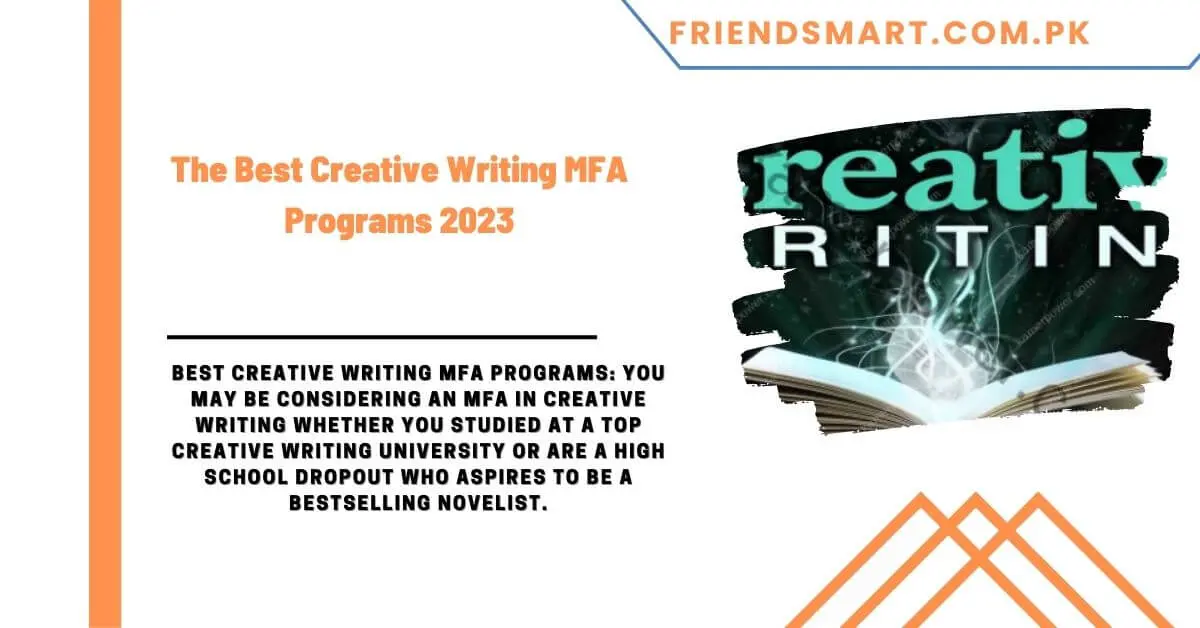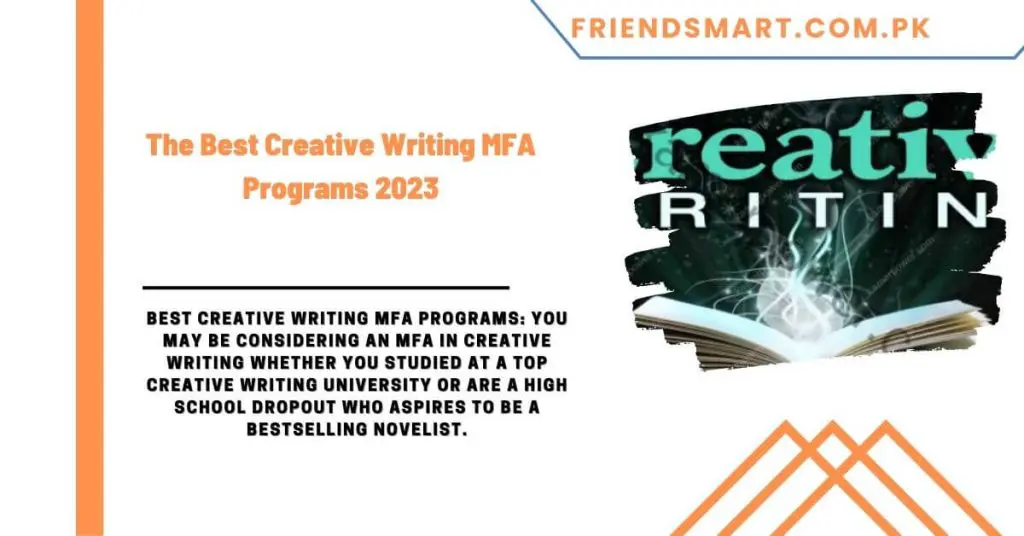The Best Creative Writing MFA Programs 2023

Best Creative Writing MFA Programs: You may be considering an MFA in Creative Writing whether you studied at a top creative writing university or are a high school dropout who aspires to be a bestselling novelist. But, is a writing MFA truly worth the time and money? How can you determine which program will help you the most with your writing? This post will walk you through the MFA program considerations as well as the best Creative Writing MFA programs in the United States.
First of all, what is an MFA?
A Master of Fine Arts (MFA) degree is a graduate degree that typically takes two to three years to accomplish. For admittance, applications demand a sample portfolio of 10-20 pages of your greatest writing.
What happens in a creative writing MFA program besides inspiring award-winning books and internet memes? You attend workshops where you receive feedback on your creative writing from your classmates as well as a faculty member. You attend seminars to gain a foundation of theory and techniques. The degree is then completed with a thesis project.

Reasons to Get an MFA in Creative Writing
To be a writer, you don’t need an MFA. Consider Nobel laureate Toni Morrison or renowned novelist Emily St. John Mandel.
Nonetheless, there are numerous reasons why you should pursue a creative writing MFA. Unfortunately, the first is prestige. An MFA from a prestigious college might help you stand out in a highly competitive publishing sector.
The second reason is a lack of time. Many MFA programs provide you with protected writing time, deadlines, and sometimes even a (small) salary.
Third, a Master of Fine Arts in Creative Writing is a terminal degree. This means that you can teach writing at the university level with this degree, especially if you produce a book.
Above all, the most important reason to seek an MFA is the community it provides. You get to meet other writers and offer comments, guidance, and moral support in long-lasting partnerships.
Types of Creative Writing MFA Programs
Depending on your requirements, the following programs should be considered:
Fully-Funded Full-Time Programs
These programs provide full-tuition scholarships and sweeten the pot by paying you to attend.
- Pros: You get paid to write (and educate).
- Cons: Uprooting your entire life to go to a potentially very chilly location.
Full-Time MFA Programs
Attending in-person classes and paying tuition are part of these programs (though many provide need-based and merit scholarships).
- Pros: A plethora of high-quality programs Non-funded programs have greater resources for attracting world-class teachers and guests.
- Cons: It is an investment that may not pay off.
Low-Residency MFA Programs
Low-residency programs often meet for brief sessions twice a year. Throughout the year, they also provide one-on-one assistance. These MFAs are more self-contained, preparing you for the realities of the writing life.
- Pros: No major life changes are necessary.
- Cons: Less time for writing and less time for friendship building.
Online MFA Programs
The event was entirely online. These programs have a high acceptance rate and do not require residence. That means no travel or relocation costs.
- Pros: No major life changes are necessary.
- Cons: These MFAs have lower brand recognition.
The Top 15 Creative Writing MFA Programs Ranked by Category
The programs listed below were chosen for their combination of substantial financing, great return on investment, stellar faculty, big journal articles, and impressive alums.
Fully Funded MFA Programs
Johns Hopkins University, MFA in Fiction/Poetry (Baltimore, MD)
This is a two-year program with teaching fellowships worth $33,000 each year. This MFA provides the most generous financial package. Not to mention the amazing health insurance, mind-boggling faculty, and a guaranteed lecture post-following graduation (nice). Unfortunately, there is no MFA in nonfiction.
- Incoming class size: 8 students
- Admissions rate: 11.1%
- Alumni: Chimamanda Adichie, Jeffrey Blitz, Wes Craven, Louise Erdrich, Porochista Khakpour, Phillis Levin, ZZ Packer, Tom Sleigh, Elizabeth Spires, Rosanna Warren
University of Texas, James Michener Center (Austin, TX)
A fully funded three-year program with a significant $29,500 stipend. The curriculum includes courses in fiction, poetry, playwriting, and screenwriting. The Michener Center is also unique in that you study a primary and secondary genre while also receiving $3,000 for the summer.
- Incoming class size: 12 students
- Acceptance rate: a bone-chilling less-than-1% in fiction; 2-3% in other genres
- Alumni: Fiona McFarlane, Brian McGreevy, Karan Mahajan, Alix Ohlin, Kevin Powers, Lara Prescott, Roger Reeves, Maria Reva, Domenica Ruta, Sam Sax, Joseph Skibell, Dominic Smith
University of Iowa (Iowa City, IA)
The Iowa Writers’ Workshop is a two-year residency program for fiction and poetry. This means that there are few requirements and plenty of time to write groundbreaking novels or play pool at the neighborhood tavern. The majority of students are supported by grants valued at up to $21,000. Gayatri Chakravorti Spivak co-founded the Translation MFA, which is similarly two years long but with more intensive instruction. The Nonfiction Writing Program is a prestigious and intense three-year MFA program.
- Incoming class size: 25 each for poetry and fiction; 10-12 for nonfiction and translation.
- Acceptance rate: 3.7%
- Fantastic Alumni: Raymond Carver, Flannery O’Connor, Sandra Cisneros, Joy Harjo, Garth Greenwell, Kiley Reid, Brandon Taylor, Eula Biss, Yiyun Li, Jennifer Croft
University of Michigan (Ann Arbor, MI)
Anne Carson famously resides in Ann Arbor, as do MFA students at the University of Michigan’s Helen Zell Writers’ Program. This is a large university town, so your social life will be less harmed. Plus, with a $23,000 stipend, summer funds, and health insurance, there’s much to do.
This is a prestigious two- to three-year curriculum. They have also proven a dedication to “push back against the darkness of intolerance and injustice” and conduct community outreach activities.
- Incoming class size: 18
- Acceptance rate: 4% (which maybe seems high after less-than-1%)
- Alumni: Brit Bennett, Vievee Francis, Airea D. Matthews, Celeste Ng, Chigozie Obioma, Jia Tolentino, Jesmyn Ward
Brown University (Providence, RI)
Brown University provides an edge, well-funded program in a climate that does not experience frigid temperatures. Students will be fully subsidized for 2-3 years, with a total of $29,926 in 2021-22. Students also receive summer assistance and, you guessed it, health insurance.
Students in the Brown Literary Arts MFA program only take one workshop and one elective per semester. It is also the country’s only program with a Digital/Cross-Disciplinary Track.
- Incoming class size: 12-13
- Acceptance rate: “highly selective”
- Alumni: Edwidge Danticat, Jaimy Gordon, Gayl Jones, Ben Lerner, Joanna Scott, Kevin Young, Ottessa Moshfegh
University of Arizona (Tucson, AZ)
This three-year program has a lot of appealing features. It is located in “the lushest desert in the world” and was recently ranked fourth in creative writing programs and second in nonfiction. You can and are encouraged to take lessons in a variety of genres. Furthermore, the dry heat of Arizona is beneficial to arthritis sufferers.
This well-known supporting program pays $20,000 a year and allows you to volunteer at a variety of literary organizations. You can also conduct funded research at the United States-Mexico border.
- Incoming class size: 9
- Acceptance rate: 4.85% (a refreshingly specific number after Brown’s evasiveness)
- Alumni: Francisco Cantú, Jos Charles, Tony Hoagland, Nancy Mairs, Richard Russo, Richard Siken, Aisha Sabatini Sloan, David Foster Wallace
Arizona State University (Tempe, AZ)
Arizona State University also has a three-year-funded arthritis-friendly dry heat program. It has one of the most remarkable professor lineups in the game, as well as small class sizes and personalized mentorships. Everyone receives a $19,000 stipend, with further financial assistance available.
- Incoming class size: 8-10
- Acceptance rate: 3% (sigh)
- Alumni: Tayari Jones, Venita Blackburn, Dorothy Chan, Adrienne Celt, Dana Diehl, Matthew Gavin Frank, Caitlin Horrocks, Allegra Hyde, Hugh Martin, Bonnie Nadzam
FULL-RESIDENCY MFAS (UNFUNDED)
New York University (New York, NY)
This two-year program is located in New York City, which means it is close to literary opportunities and hot dogs. NYU is a private university with one of the most accomplished faculty lists in the country. Students have big cohorts (more potential buddies!) and a proclivity toward winning prestigious literary awards.
- Incoming class size: 40-60
- Acceptance rate: 6%
- Alumni: Nick Flynn, Nell Freudenberger, Aracelis Girmay, Mitchell S. Jackson, Tyehimba Jess, John Keene, Raven Leilani, Robin Coste Lewis, Ada Limón, Ocean Vuong
Columbia University (New York, NY)
Another private MFA program for 2-3 years with drool-worthy permanent and visiting instructors. Courses in fiction, poetry, translation, and nonfiction are available at Columbia. Aside from Ivy League education, Columbia provides intimate access to agencies, and its students have a strong track record of bestsellers.
- Incoming class size: 110
- Acceptance rate: 21%
- Alumni: Alexandra Kleeman, Rachel Kushner, Claudia Rankine, Rick Moody, Sigrid Nunez, Tracy K. Smith, Emma Cline, Adam Wilson, Marie Howe, Mary Jo Bang
Sarah Lawrence (Bronxville, NY)
Sarah Lawrence’s speculative fiction courses go beyond the typical fiction, poetry, and nonfiction offerings. This program is unusual because it offers biweekly one-on-one sessions with its outstanding teachers, despite its small class sizes. It also offers a well-known supportive environment.
- Incoming class size: 30-40
- Acceptance rate: N/A
- Alumni: Cynthia Cruz, Melissa Febos, T Kira Madden, Alex Dimitrov, Moncho Alvarado
LOW RESIDENCY
Bennington College (Bennington, VT)
This two-year program has an outstanding faculty and meets for ten days twice a year in January and June. It’s like taking a yearly trip to lovely Vermont, plus getting mentored by a famous writer, and then getting a degree. The annual price is $23,468 with scholarships available.
- Acceptance rate: 53%
- Incoming class: 40
- Alumni: Larissa Pham, Andrew Reiner, Lisa Johnson Mitchell
Institute for American Indian Arts (Santa Fe, NM)
The focus of this two-year program is Native American and First Nations writing. They provide a wide range of genres in screenwriting, poetry, fiction, and nonfiction, with genuinely excellent faculty and visiting writers.
Each year, students attend two eight-day residencies in Santa Fe, New Mexico, in January and July. It offers a yearly salary of $12,000
- Incoming class size: 22
- Acceptance rate: 100%
- Alumni: Tommy Orange, Dara Yen Elerath, Kathryn Wilder
Vermont College of Fine Arts
One of the few MFA programs that focuses on the art of the picture book, middle grade and young adult literature, graphic literature, nonfiction, fiction, and poetry for children. Students gather in Vermont for nine days twice a year, in January and July. There are also several vacation residencies available in fascinating (and warm) locations such as Cozumel.
VCFA has an outstanding faculty and visiting writers, as well as tailored study alternatives and ample one-on-one time. Tuition is $48,604 per year.
- Incoming class size: 18-25
- Acceptance rate: 63%
- Alumni: Lauren Markham, Mary-Kim Arnold, Cassie Beasley, Kate Beasley, Julie Berry, Bridget Birdsall, Gwenda Bond, Pablo Cartaya
ONLINE MFAS
University of Texas at El Paso (El Paso, TX)
It is the world’s first multilingual and online MFA program. UTEP has the greatest online MFA program with award-winning teachers from all around the world. Intensive workshops allow for submissions in both Spanish and English, as well as poetry and fiction. This three-year program costs $14,766 per year and accepts students on a rolling basis.
- Acceptance rate: 100%
Bay Path University (Long Meadow, MA)
This two-year online degree focuses solely on nonfiction. Bay Path is a welcoming, varied community that provides small class sizes, close mentorship, and the possibility of a field trip to Ireland.
There are other routes available, including publishing, Narrative Medicine, and teaching. Memoir, narrative journalism, and personal essay are all required courses. The cost per credit is $785 for 39 credits, with scholarships available.
- Incoming class size: 20
- Acceptance rate: an encouraging 78%
People Also Ask
-
What is the best MFA creative writing program?
MFA in Fiction/Poetry, Johns Hopkins University (Baltimore, MD) This is a two-year program with teaching fellowships worth $33,000 each year. This MFA provides the most generous financial package.
-
What is the acceptance rate for writing MFA?
Because MFA programs are highly competitive (with acceptance rates frequently hovering around 2% or 3%), it’s often recommended that you apply to around ten schools unless you have certain limits.



